
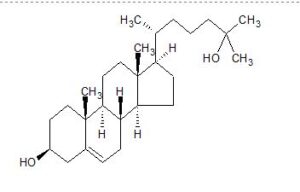
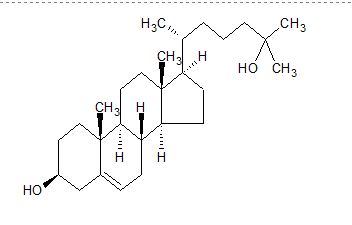
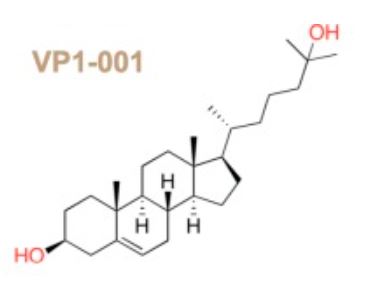
VP1-001
CAS 2140-46-7
Cholest-5-ene-3,25-diol, (3β)-Molecular Weight, 402.65, C27 H46 O2
- Cholest-5-ene-3β,25-diol (8CI)
- (3β)-Cholest-5-ene-3,25-diol
- 25-Hydroxy-5-cholestene-3β-ol
- 25-Hydroxycholesterol
- 5-Cholesten-3β,25-diol
Compound 29 – ViewPoint Therapeutics
- Originator University of California at San Francisco; University of Michigan; University of Washington
- Developer University of California at San Francisco; University of Michigan; University of Washington; ViewPoint Therapeutics
- Class Small molecules; Sterols
- Mechanism of Action Amyloid inhibitors; Protein aggregation inhibitors; Protein folding inhibitors
- 28 Jun 2020 No recent reports of development identified for research development in Presbyopia in USA (Ophthalmic, Drops)
- 28 Dec 2019 No recent reports of development identified for preclinical development in Cataracts in USA (Ophthalmic, Drops)
- 01 Apr 2016 ViewPoint Therapeutics receives SBIR grant from National Eye Institute for VP1 001 development in Cataracts (ViewPoint Therapeutics website)
CLIP
https://europepmc.org/article/PMC/6676924
We previously identified an oxysterol, VP1-001 (also known as compound 29), that partially restores the transparency of lenses with cataracts. To understand the mechanism of VP1-001, we tested the ability of its enantiomer, ent-VP1-001, to bind and stabilize αB-crystallin (cryAB) in vitro and to produce a similar therapeutic effect in cryAB(R120G) mutant and aged wild-type mice with cataracts. VP1-001 and ent-VP1-001 have identical physicochemical properties. These experiments are designed to critically evaluate whether stereoselective binding to cryAB is required for activity.
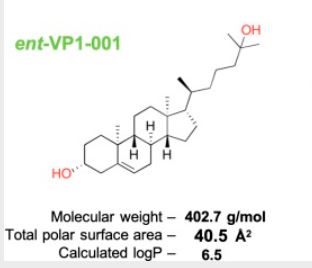

SYN https://europepmc.org/articles/PMC6676924/bin/iovs-60-07-63_s01.pdf


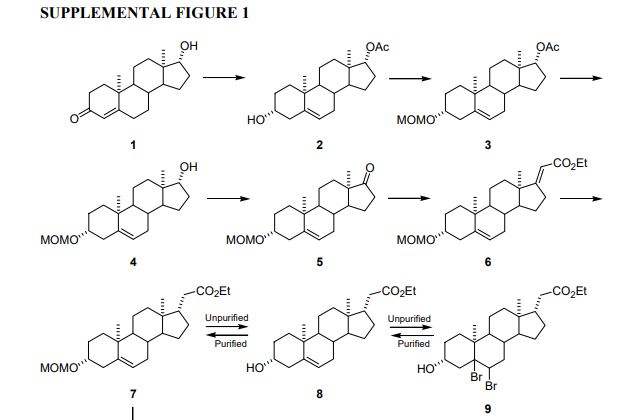
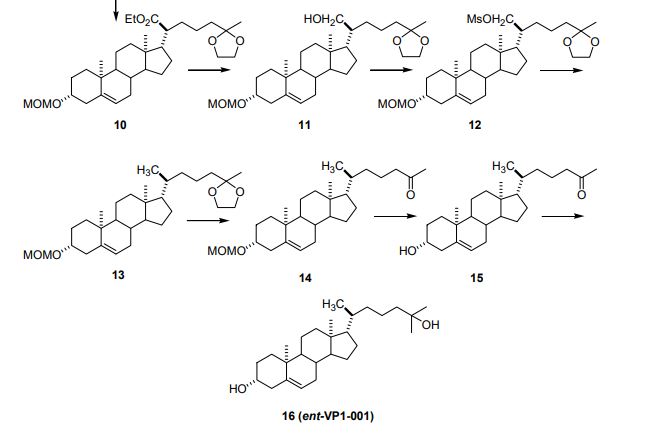
ref
- (2) Ogawa, Shoujiro; Steroids 2009, Vol74(1), Pg81-87
- (7) Beckwith, A. L. J.; Journal of the Chemical Society 1961, Pg3162-4
- (8) Beckwith, A. L. J.; Proceedings of the Chemical Society, London 1958, Pg194-5
- (9) Dauben, William G.; Journal of the American Chemical Society 1950, Vol72, Pg4248-50
- (10) Fieser, Louis F.; Journal of Organic Chemistry 1957, Vol22, Pg1380-4
- Ogawa, Shoujiro; Steroids 2009, Vol74(1), Pg81-87
https://www.sciencedirect.com/science/article/abs/pii/S0039128X08002432
A solution of the 3-acetate 2a (200mg, 0.45mmol) in 5%
methanolic KOH (20mL) was refluxed for 1 h. After evaporation of the solvent, the residue was dissolved in CH2Cl2, and
the solution was washed with water, dried with Drierite® and
evaporated in vacuo. Recrystallization of the oily residue from
aq. methanol gave the 3,25-dihydroxy-5-ene 2b as colorless
needles: yield, 163mg (90%). m.p. 178–180 ◦C. (lit. 178–180 ◦C
[32]). IR (KBr), max cm−1: 3301 (OH). 1H NMR (CDCl3) ı: 0.68
(3H, s, 18-CH3), 0.93 (3H, d, J 5.4, 21-CH3), 1.01 (3H, s, 19-CH3),
1.21 (6H, s, 26- and 27-CH3), 3.50 (1H, br. m, 3-H), 5.34 (1H, br.
s, 6-H). 13C NMR (CDCl3) ı: 11.9 (C-18), 18.7 (C-21), 19.4 (C-19),
20.7 (C-23), 21.1 (C-11), 24.3 (C-15), 28.2 (C-16), 29.2 and 29.3 (C26 and C-27), 31.6 (C-2), 31.9 (C-7), 31.9 (C-8), 35.7 (C-20), 36.4
(C-22), 36.5 (C-10), 37.2 (C-1), 39.8 (C-12), 42.3 (C-4 and C-13),
44.4 (C-24), 50.1 (C-9), 56.0 (C-17), 56.7 (C-14), 71.1 (C-25), 71.8
(C-3), 121.7 (C-6), 140.7 (C-5). LR-MS (EI), m/z: 402 (M+, 65%), 384
(M−H2O, 100%), 369 (M−H2O–CH3, 53%), 366 (M−2H2O, 21%),
351 (M−2H2O–CH3, 34%), 317 (M−H2O–ring A–part of ring B,
13%), 299 (M−2H2O–ring A–part of ring B, 29%), 273 (M−S.C.,
75%), 255 (M−H2O–S.C., 31%), 245 (24%), 231 (M−S.C.–ring D,
22%), 213 (M−H2O-CH3–S.C.–part of ring D, 43%). HR-MS (EI),
calculated for C27H46O2 [M+], 402.3498; found m/z: 402.3498.

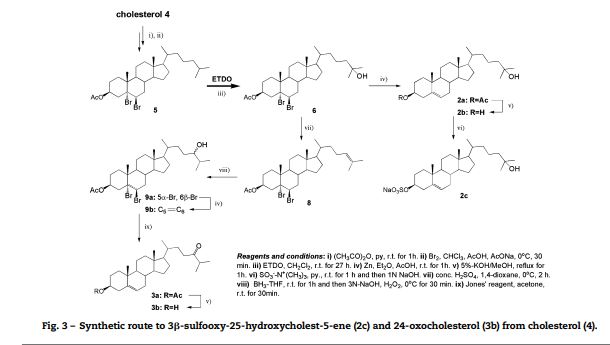
//////////

AS ON DEC2021 3,491,869 VIEWS ON BLOG WORLDREACH AVAILABLEFOR YOUR ADVERTISEMENT

join me on Linkedin
Anthony Melvin Crasto Ph.D – India | LinkedIn
join me on Researchgate
RESEARCHGATE

join me on Facebook
Anthony Melvin Crasto Dr. | Facebook
join me on twitter
Anthony Melvin Crasto Dr. | twitter
+919321316780 call whatsaapp
EMAIL. amcrasto@amcrasto
/////////////////////////////////////////////////////////////////////////////

NEW DRUG APPROVALS
TO MAINTAIN SUBSCRIPTION OF THIS BLOG
$10.00
CLIP
A Noninvasive Alternative to Cataract Surgery?
Investigators are exploring chemical compounds to restore transparency to the crystalline lens.
Surgery is an effective but costly means of managing cataracts, and, like all surgical interventions, it carries risks. Moreover, a substantial number of people worldwide, particularly in developing countries, lack access to cataract surgery. The World Health Organization estimates that 65.2 million people globally are blind or visually impaired from cataracts.1 The development of an eye drop that restores transparency and flexibility to the crystalline lens would therefore be a game-changer as a less expensive, noninvasive option for treating a leading cause of blindness.
RESEARCH RESULTS
The crystalline lens is composed of epithelial and fiber cells. One of the major lens proteins in the fiber cells is alpha-crystallin, a chaperone protein thought to maintain homeostasis of the crystalline lens, thereby preserving its transparency and flexibility. As a person ages, alpha-crystallin proteins become prone to misfolding, causing them to clump together and form insoluble high-molecular-weight protein aggregates, which can lead to cataract formation.
Compound 29 (full name, 5-cholesten-3beta,25-diol), also known as VP1-001 (ViewPoint Therapeutics) and as 25-hydroxy-cholesterol, is an oxysterol, a derivative of cholesterol. Usha Andley, PhD, FARVO, is an investigator conducting research on this chemical compound’s use as a treatment for cataracts.2,3 Another oxysterol being investigated for this purpose is lanosterol. In a recent study, neither oxysterol was effective at reducing opacities of in vitro cultured lenses treated with various reagents to induce opacification in vitro.4 In an interview with ME, however, Dr. Andley stated that VP1-001 appears to be more effective than lanosterol at reducing lens opacity. VP1-001 differs from lanosterol in terms of solubility, she said, allowing VP1-001 to penetrate the eye better.
The goal of the research being conducted by Dr. Andley and her colleagues, she said, is twofold:
No. 1: To ensure that the compound is not toxic to the cornea; and
No. 2: To show that the compound is capable of reducing the tendency of alpha-crystallins to aggregate and perhaps reverse their aggregation.
In proof-of-concept studies, VP1-001 was incorporated into an eye drop formulation of 8% cyclodextrin. Dr. Andley and colleagues administered the drops three times per week in a mouse model for 2 to 4 weeks. According to Dr. Andley, the compound seemed to increase the stability of the alpha-crystallin protein so that it increased the soluble fraction of proteins from mouse and human lens cataracts. The compound also increased the solubility of two other lens crystallins, beta- and gamma-crystallin, in the mouse lens, and it seemed to reduce the abundance of high-molecular-weight aggregates in the lens.2,3
ViewPoint Therapeutics is currently developing this technology for use in humans. According to Dr. Andley, who is working with the company, ViewPoint Therapeutics is using different model systems for in vitro and protein-binding studies in an attempt to improve on earlier results with the chemical compound. Their research has identified new compounds, nonsterol ligands for alpha-crystallin, that exhibited in vitro activity and efficacy similar to or better than those of VP1-001 in mouse models of cataracts.5 The discovery of these nonsterols supports the hypothesis that pharmacologic chaperones targeting alpha-crystallin can prevent or reverse cataracts, Dr. Andley said.
CHALLENGES AND FUTURE DIRECTIONS
In studies to date, Dr. Andley and her colleagues have treated mice in one eye with the VP1-001 formulation, and the contralateral untreated eyes have served as controls. They then compared the two eyes after the conclusion of treatment (Figure). She is looking forward to conducting masked and randomized studies that include baseline measurements of lens opacity. According to Dr. Andley, this research will begin this year. Animal testing, however, can advance understanding only so far. Human testing of safety and efficacy will be a major step forward in the research on VP1-001 and newer variants.
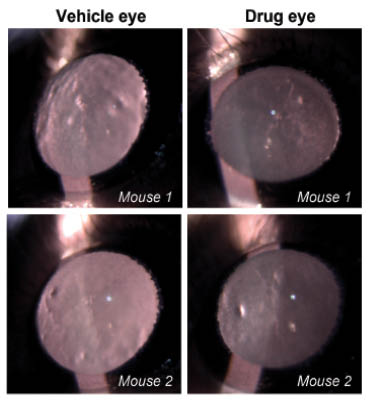
Figure | Representative slit-lamp images from aged wild-type mouse lenses show the extent of opacity treated with vehicle (left) or drug (right). Mice were treated topically with the drug in one eye and vehicle in the contralateral eye three times per week for 2 weeks. Slit-lamp examinations were performed on conscious, live mice. Mouse 1 and 2 were treated with VP1-001.
A major challenge in the development of a pharmacologic treatment for cataract is how to determine if a chemical compound can be maintained in the lens at a sufficient concentration and for an adequate duration to achieve the desired outcome. A second challenge relates to detecting change. Dr. Andley and her colleagues are seeking a more quantitative method by which to assess the extent of lenticular opacity before and after treatment. They have a modified Lens Opacities Classification System, she said, but it is less objective than methods such as Scheimpflug photography. A goal, then, is to develop a more standardized, objective way of measuring results.
In addition to age-related cataract, Dr. Andley suggested, a topical agent could be advantageous for the treatment of congenital cataracts that form because of a mutation in alpha A crystallin or alpha B crystallin. Retaining the crystalline lens instead of extracting it would allow pediatric eyes to develop normally, she noted.
The idea of an eye drop formulation to treat cataracts may seem like science fiction, but Dr. Andley expects it to become a more realistic possibility within the next few years. The utility of such a chemical compound could extend beyond cataracts to the treatment of presbyopia. The hypothesis, she said, is that softening the crystalline lens would improve accommodative amplitude.
1. World Health Organization. Blindness and vision impairment. https://www.who.int/news-room/fact-sheets/detail/blindness-and-visual-impairment. Published October 8, 2019. Accessed January 22, 2020.
2. Makley LN, McMenimen KA, DeVree BT, et al. Pharmacological chaperone for α-crystallin partially restores transparency in cataract models. Science. 2015;350(6261):674-677.
3. Molnar KS, Dunyak BM, Su B, et al. Mechanism of action of VP1-001 in cryAB(R120G)-associated and age-related cataracts. Invest Ophthalmol Vis Sci. 2019;60(10):3320-3331.
4. Daszynski DM, Santhoshkumar P, Phadte AS, et al. Failure of oxysterols such as lanosterol to restore lens clarity from cataracts. Sci Rep. 2019;9(1):8459.
5. Dunyak B, Su B, Molnar K, et al. Discovery of non-sterol aB-crystallin ligands as potential cataract therapeutics. Invest Ophthalmol Vis Sci. 2019;60(9):5691.
///////////VP1-001 , occular

 DRUG APPROVALS BY DR ANTHONY MELVIN CRASTO
.....
DRUG APPROVALS BY DR ANTHONY MELVIN CRASTO
.....

I have a cat with diabetic cataracts, who cannot have surgery. Sign us up, if you want a Canadian feline volunteer. I believe my email will be attached to this comment on your end?
LikeLike
When will this expected to be approved for humans to use?
LikeLike
Is This new drug VP1-001 (Compound 29) available to the public? If so, how do I purchase them? f not, is it likely to be available soon? Do the trials show they are safe to use? Thank you for your reply.
LikeLike